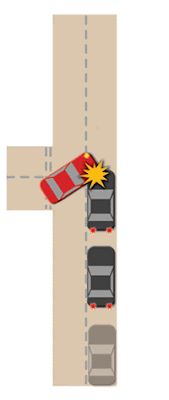You may have heard that it's possible to slow down quicker in a car without ABS. This has elements of truth, but in practical terms the benefits of ABS massively outweigh the slightly longer braking distances. For road use, ABS is an absolute must as it will allow you to steer out of the way of unexpected hazards.
Diagrams 2 and 3 below explain the practical reasons for ABS.
Diagrams 2 and 3 below explain the practical reasons for ABS.
Diagram 2: Braking hard on a slippery surface with ABS
In the diagram above, the driver hits the brakes hard on a slippery surface (1), then steers (2), and successfully manages to avoid the obstacle. ABS prevents the wheels from locking, and this allows you steer.
Diagram 3: Braking hard on a slippery surface without ABS
Without ABS, as the driver applies the brakes the wheels lock (1). Despite applying steering lock, the car continues straight ahead due to the loss of steering control (2) and a collision results.
This is another example;
This is another example;
If done correctly, threshold braking can slow a vehicle more quickly that a car fitted with ABS (in the right conditions). Many competitive racing drivers would say that they prefer their cars not to have the system. However, to gain maximum advantage you will need to practice the threshold braking technique repeatedly. A good test is to find a section of test-track, and mark out a cone which will act as the braking point. Accelerate to 60 or 70mph and brake as hard as you can in a car equipped with ABS, then repeat without ABS. Compare the stopping distances by having someone mark them on the side of the track, then practice threshold braking until you notice a marked improvement. If you do have ABS fitted, don't get into the habit of locking up wheels before entering a corner - this isn't the quickest way of slowing down and can unsettle the car.





Good job!Clear picture and simple explanation..
ReplyDelete